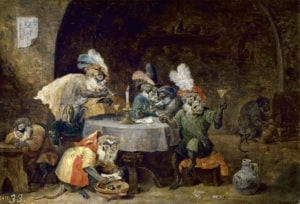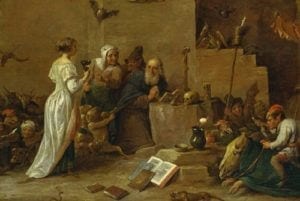Mirjana Stojkovic-Ivkovic
Belgrade, Serbia

David Teniers the Younger (1610–1690) was one of the most prolific and versatile Flemish artists. About 2000 pictures have been attributed to him, including replicas and copies, and at least 900 paintings have been accepted as his genuine work. In his lifetime he was respected as one of the greatest painters of Europe. His paintings may be found in many of the great museums of Europe and America, and he also created tapestries, graphics, and copper plates. His technique was characterized by sophisticated and subtle colors, excellent coloring, and precise lines and shadows. He painted landscapes, conversation pieces, mythological scenes, historical scenes, allegorical scenes, and still nature, and was known for his scenes of kermises, alchemy, and interior galleries. He painted real-life scenes of rural life, of different social strata, dances, weddings, fights, fairs, festivals, and carnivals. His specialties were the interiors (kitchens, stables, and taverns). Famous paintings include the ten pictures of Archduke Leopold Wilhelm’s gallery in Brussels, now exhibited at the Kunsthistorisches Museum in Vienna, and the Flemish Kermes, an outdoor villagers’ celebration with food, drink, dance, music shown at the Royal Museum of Fine Arts in Brussels.

Born in 1610, Teniers married in 1637 Anna Brueghel, daughter of Jean Brueghel, who brought a significant dowry.2 The wedding was attended by Rubens and his second wife. In addition to painting, Teniers also worked as an art dealer from 1640 to 1641. He got a passport, “a painter and art dealer David Teniers.” He was Dean of the Antwerp Artist Society (1645–1646) and from 1647 was employed by Governor of South Holland, Archduke Leopold Wilhelm, as official painter to the Court and as the guardian of his pictures. He painted pictures for the Queen of Sweden, the exiled King Charles II of England, and the Spanish King.1 After the death of his wife in 1656 he bought a house in Brussels. By that time he had become very rich. He subsequently married the daughter of the Council Secretary, Isabella Fran. Later his sons from his first marriage took legal action against him for the ownership of the castle where he lived; but the Spanish King granted his request to become a nobleman but provided that he must quit the art dealership and stop taking money for his painting. He did not honor the agreement. He died in 1690.
In his paintings Teniers often reminds the viewer of the transience and unworthiness of earthly goods. He painted the temptations of saints with some fabulous views of the fantastic and devilish temptations and monkeys making fun of human silliness. (Fig 1) At one stage of his life David Teniers painted under the direct influence of alcohol, often in a hallucinatory state or delirium tremens, inevitably accompanied by a strong feeling of fear. Those remembered details he would paint faithfully, some creating the impression that the artist had just witnessed the hell he painted. Portraying the vision of a delirious patient, these images represent the confession of a sick mind and mirror the darkest side of the human soul. One such painting (Fig 2) shows gross reptiles and mad dogs wanting to attack the helpless victims. Bats are flying around people or sucking their blood; snakes and worms are entering the skin. The fear is engraved in the people’s faces.

In the painting shown in Fig 3, the artist, holding a pitcher and a glass, is chained to symbolize physical and psychological addiction to alcohol. One gains the impression that he had separated himself from that group of lower class people to which he felt he did not belong. He may have felt guilt and shame for being there; the red bulbous nose and red face being characteristic of the chronic alcoholic.
These pictures are likely to originate from a person who has witnessed such visions. Created during alcoholic episodes, they document the state of the artist and are interesting in observing a condition such as alcoholism. Hangovers and depressive conditions between drinking episodes slow the independent thinking process and emotions; associations become poor and inspiration vanishes. The hand becomes too weak to follow the mind, strong tremors do not allow the artist to hold the paintbrush, and strokes become imprecise. The aesthetic quality of Teniers’ work is questionable, and in a way his drinking may have prevented him from occupying the place in the history of art that he deserves, for in many cases chronic alcoholism slowly but surely destroys creative ability.
References
- https://eu.wikipedia.org/wiki/David_Teniers_the_younger (20.08.2016).
- https://www.britanica.com/biografy/David -Teniers-the younger (20.08.2016).
MIRJANA STOJKOVIC-IVKOVIC graduated from the Nis University School of Medicine and specialized in psychiatry at VMA Belgrade. She is a practicing psychiatrist in Belgrade.
Highlighted in Frontispiece Summer 2017 – Volume 9, Issue 3 & Volume 10, Issue 1 – Winter 2018

Leave a Reply